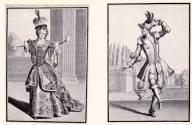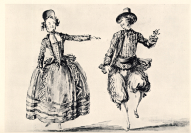 Men,
Women & the 18th c. Ballet
Men,
Women & the 18th c. Ballet
As the techniques of the court ballets increased in athleticism,
they may have become less appropriate for women. Certainly the limitations
imposed
on
their
movement
by their very clothing would
indicate that rigorous actions were not anticipated in the movements of
the noble woman. As well, exposing a considerable expanse
of one’s leg was deemed highly improper for women, keeping hemlines
conservatively long (Soloman-Godeau
1986). This was not the case for men,
however. Strong and shapely legs were considered an asset in a man and
one to be
flaunted (Beaumont 1946,
Lee 1999). Strict adherence
to this element of decorum even prevented women from playing female roles
in eighteenth-century ballets.
Dancing en travesti,
i.e. in drag, men often took up the  roles
of women in the courtly ballet productions, wearing masks and dressing
accordingly (Lee 1999).
While women were confined to carrying out secondary roles, the aristocratic
danseur was the focus of the eighteenth-century ballet and used these courtly
performances to display his athleticism and gallantry. However, the French
Revolution ushered in new ideologies, and once again fashion lent these
ideas material form (McCracken
1988). In turn, these developments began
to transform the ballet, shifting the spotlight from exhibitions of masculine
strength
and
agility to spectacles of female grace and beauty.
roles
of women in the courtly ballet productions, wearing masks and dressing
accordingly (Lee 1999).
While women were confined to carrying out secondary roles, the aristocratic
danseur was the focus of the eighteenth-century ballet and used these courtly
performances to display his athleticism and gallantry. However, the French
Revolution ushered in new ideologies, and once again fashion lent these
ideas material form (McCracken
1988). In turn, these developments began
to transform the ballet, shifting the spotlight from exhibitions of masculine
strength
and
agility to spectacles of female grace and beauty.